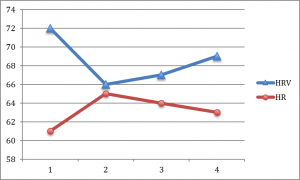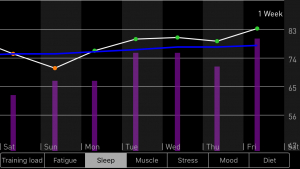Some body measures, such as height and weight can be taken as many times as you like within a short period of time, and you will always get the same number. But many biological measures are not like that, especially ones that measure physiological quantities such as blood composition or hormones that are present in only small amounts and are difficult to measure accurately. Take blood glucose for instance, which has a typical measurement error of close to 10%, and may be 20% off a reference value whilst still meeting the International Standards Organisation measurement requirements.
Measurements like blood pressure and heart rate variability (HRV) come into a slightly different category though. Assuming a well-designed measurement device, the measurement may be accurate, but results are affected by small bodily and mental changes both during and between measurements. A lot of users ask us about this, and if they offer their data, it often looks something like the chart of real data below.

This is a series of 4 ithlete measurements taken in quick succession. As you can see, the first is the highest, the second the lowest, and the third and fourth head back towards the first reading, but don’t quite get there. You can see that these are valid, accurate measurements though, because the resting heart rate follows the opposite trend to the HRV.
The problem is that these are not independent measurements because you know the result of each one and this introduces a subliminal stress, especially for the second reading where you are anxiously wondering whether the reading is going to be the same (you become calmer again as the process goes on).
The degree to which back to back readings vary also depends on how carefully you perform the measure, e.g. if you are in the same body position, and if you are following the ithlete breathing pacer. Breathing depth and rate have a large effect on HRV, which is why we standardise this aspect.
So just because you see variations in back to back measures doesn’t mean the HRV tool is inaccurate, or that your daily morning measure will have the same amount of variation. Take a look at my data for this week for example, four days of good sleep, reasonable diet, and low intensity training has produced very consistent readings because the conditions were also consistent.

If you know for sure that something went wrong with your morning measure and you need to repeat it, we suggest waiting for 3-5 minutes for your body to stabilize again before doing another measure.

Thank you for this insight. This is something that has been worrying me recently, particularly when I’ve arranged to go cycling with a friend and don’t want to let them down. It is amazing just how sensitive HRV readings are.
No problem Sonja! HRV is sensitive and some people (mistakenly) interpret back to back reading variation as inaccuracy, but it really isn’t because it behaves in a consistent way.
Glad the post helped. Simon.
I made an interesting discovery this morning: For 2 weeks, from 20 Nov to 3 Dec my sleep app measured my RHR in the 40’s (44-48) (It is usually in the 50’s). During this same period I had a Green HRV reading in the 90’s. I don’t look at my sleep stats until I’ve measured my HRV so there is no influence. It just proves to me …as in this article…how important sleep/recovery is.
Absolutely Sonja, and training, nutrition & stress during the day also determine how well we are likely to sleep, so habits become self reinforcing.